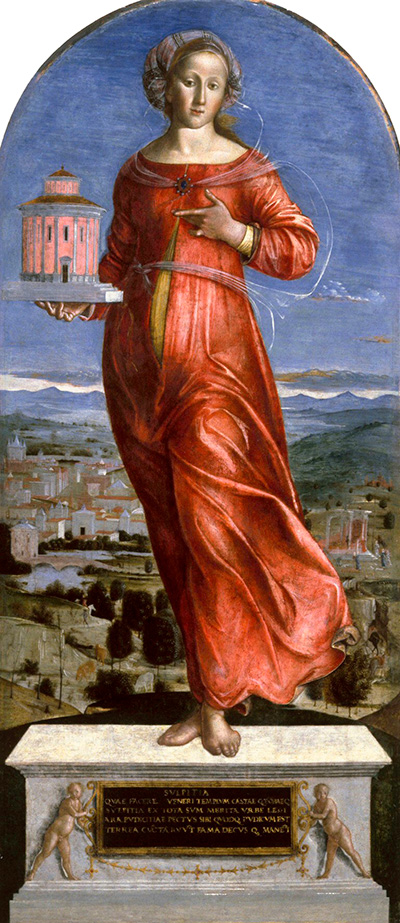Sappho's poetry was a stimulus for a long list of women who, until the 4th century AD, captured their voices in various styles, both in Greek and Latin. From Roman times, mentioning only the poets of whom minimum testimony remains, we find Sulpicia "the elegiac poetess", Melinno, Herennia Procula, Claudia Trophime, Sulpicia "the satirist", Julia Balbilla, Caecilia Trebulla, Damo, Terentia, Theosebia and Aconia Fabia Paulina.

Sulpicia
(the elegiac)
1st century BCE; b. Roma
Period of activity: 20 BCE — ?
Geographical classification: Europe > Italy
Socio-cultural movements
Antiquity > Roman culture > Republic
Groups by dedication
Writers > Poets
Writers > in > Latin
Context of feminine creation
Review
Sulpicia lived in Rome during the reign of Augustus, she was the daughter of the orator Servius Sulpicius Rufus and the niece of Marcus Valerius Messalla. She frequented intellectual circles and is the only Roman poetess of the Classical period whose work has been transmitted to us. The so-called Sulpician Cycle has been preserved in Book III of the corpus of poems by the elegiac poet Tibullus. It is composed of a group of poems (from 13 to 18) as epistulae amatoriae, where the author shamelessly discovers feelings which are contrary to social norms.
Justifications
Biography
Sulpicia expresses her ancestry, with more or less clarity, in some of her verses. Servius Sulpicius Rufus is the full name of her father. Her mother, Valeria, is the sister of Marcus Valerius Messalla, general and founder of the Messalla Circle. Sulpicia lost her father and was soon under the tutelage of her maternal uncle. This, in addition to a social position without difficulties, must have facilitated her full integration in an environment of literary creation, as well as her contact with some of the most important poets of the moment, such as the elegiac Tibullus.
Her love story with Cerinthus, a Roman whose condition, origin, dedication and even real name are unknown, is drawn from reading her poems.
Regarding the relationship between Sulpicia and the poet Tibullus, they are thought to have had at least frequent contact, eased by the fact that they both belonged to the circle of Sulpicia's uncle. In addition, a group of poems from the Corpus Tibullianum (the set of compositions signed by Tibullus), specifically those that go from 13 to 18, contain an undoubted declaration of authorship: her name clearly appears, there are allusions to her specific vital time and, as with other elegiacs, the name of her beloved is included. Written in the tone and form of short love letters, their theme is the author's love for Cerinthus, whom historians have tried to identify with the aristocrat Caecilius Cornutus, alluded in two of Tibullus poems.
For a long time, scholars considered Sulpicia an amateur author without literary value. This change of focus towards valueing her work as a genuine literary expression is very recent, from the last decades of the 20th century.
The figure and poetry of Sulpicia are less known than those of Sappho. It is also completely ignored in the canon, as it happened with Corinna. Under her name, history has bequeathed us an interesting collection of verses which are inspiring, despite their incomplete nature. In them, a voice that rises strongly against conventions and “what people might say”, and infinite and suggestive interpretive possibilities are sensed.
García-Gasco, Rosa (2019). “Sulpicia. Dos poetisas olvidadas”, in Blog: Teo Palacios, (retrieved on 14-05-2021), <https://teopalacios.com/sulpicia-dos-poetisas-olvidadas-con-el-mismo-nombre/>
Bibliography
-Alvar, Antonio (1993). Poesía de amor en Roma, Catulo, Tibulo, Lígdamo, Sulpicia, Propercio. Madrid: Akal/Clásica.
-Cantarella, Eva. (1997). Pasado próximo: mujeres romanas de Tácita a Sulpicia. Madrid: Cátedra , pp.181-188.
-López, Aurora (1994). No sólo hilaron lana. Escritoras romanas en prosa y verso. Madrid: Ediciones Clásicas, pp. 75-94.
-Luque, Aurora (2020). Grecorromanas. Lírica superviviente de la Antigüedad clásica. Barcelona: Planeta, pp. 206-218.
-González, Berta. (2012).“La obra de una Docta puella (Tibul. Carmina III 13-18)”, en Quaderns de Filologia. Estudis literaris, vol. XVII, pp. 59-64, (retrieved on 14/05/2021), <https://dialnet.unirioja.es/servlet/articulo?codigo=4145299>
Didactic approach
-CUC: Block Classical roots of today's world. Everyday life; Block Continuity of cultural heritage. Literature, art and science.
-Latin 4th ESO: Block Latin text and translation; Block Legacy and heritage.
-Latin Baccalaureate: Block The text: comprehension and translation; Block Literary education.
-Universal Literature 1st Baccalaureate: Interpretation of fragments from the Roman period of different genres and themes.
-Spanish Language and Literature ESO: Literary Education Block.